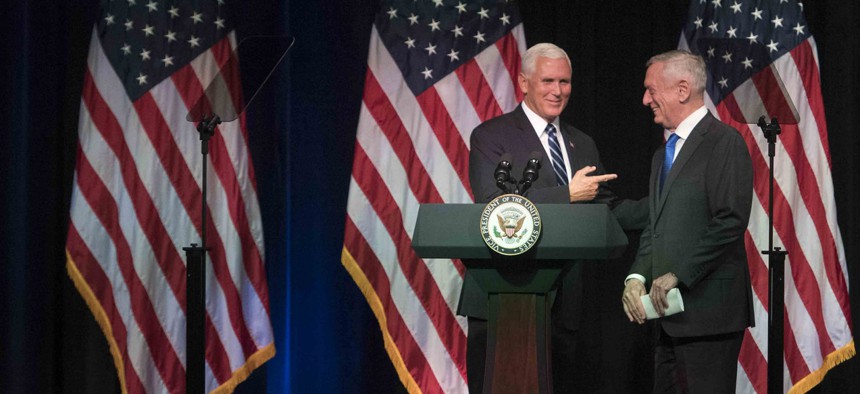
At the Pentagon, Vice President Mike Pence and Defense Secretary Jim Mattis announce the Trump administration's plan to create a new military service branch, Space Force, on Thurs., Aug. 9, 2018. DoD photo by Tech Sgt. Vernon Young Jr.
Pence Makes Hard Sell For Trump's Space Force by 2020
The administration wants a new military service branch, but space mission's future in the Pentagon and Congress is far from certain.
The Trump administration officially rolled out its roadmap to create a U.S. Space Force, the first new military branch in over 70 years by 2020 — assuming Congress complies.
Vice President Mike Pence unveiled a plan to ask Congress for the authority and funds to set up the U.S. Space Force as a sixth branch of the armed forces, calling the proposal “an idea whose time has come.”
The Defense Department will kick into action a series of steps that it can take without Congress by the end of the year, including the creation of a new combatant command for space and new space war-fighting and weapons-buying units that will eventually become part of the Space Force. A draft of the plans were first reported by Defense One last week.
“As their actions made clear, our adversaries have transformed space into a warfighting domain already,” Pence said in a speech at the Pentagon on Thursday. “The U.S. will not shrink from this challenge.”
A final report to Congress made public Thursday morning also calls for the creation of a new Space Development Agency to modernize technology development and acquisitions.
Pence also announced the creation of a new civilian position — assistant secretary of defense of space — reporting to Defense Secretary Jim Mattis to oversee the creation of the new branch. He did not announce a nominee.
Although the Pentagon can move forward with the first steps in its proposal — the creation of the warfighting unit and U.S. Space Command, a new combatant command that likely would train and manage troops pulled from all service branches — it needs congressional authorization to stand up the U.S. Space Force as a new service branch equal to the Army, Navy, Air Force, and Marines. And that authorization is far from assured. The concept has some Republican support in the House, but it has faced opposition in the Senate, where key lawmakers have warned it would create an unnecessary layer of bureaucracy. Mattis has in the past opposed standing up a new branch, arguing that a separate service “would likely present a narrower and even parochial approach to space operations.” The defense secretary on Tuesday told reporters that he and Trump were in “complete alignment,” indicating that he supported the creation of the new U.S. Space Command but stopping short of promising a separate branch.
A bipartisan majority of the House signaled its support for a new space organization last year, tucking a provision into the 2018 defense policy bill that would have created a new branch within the Air Force, similar to the way the Marine Corps is part of the Department of the Navy. That provision was stripped out during conference negotiations with the Senate.
Trump will have to include his request for a full Space Force in the fiscal year 2020 budget request due to Congress in February, punting the real fight over a new service branch until late next year.
Pence on Thursday said the administration has begun working with Congressional leaders to secure legislative approval for the plan, calling out a handful of House lawmakers like Armed Services Committee leaders Rep. Mac Thornberry, R-Texas, and Rep. Adam Smith, D-Wash. He did not name any senators, including James Inhofe of Oklahoma, the No. 2 Republican on the Senate Armed Services Committee. Inhofe has repeatedly said he opposes the move. Should Republicans maintain control of the Senate after November’s elections as expected, and if the ailing Sen. John McCain, R-Ariz, is unable to resume his duties as committee chair next year, it would fall to Inhofe to manage the bill.
“Creating a new branch of the military is not a simple process,” Pence said.
Related: EXCLUSIVE: Pentagon To Start Creating Space Force — Even Before Congress Approves It
The debate over the need for a separate branch of the military to handle space-related defense predates Trump by several administrations. Proponents of the move say that the U.S. risks being outpaced by China or Russia, who could pose a serious threat to American intelligence and communications satellites.
The report issued to Congress in Thursday largely tracks with a draft version reported by Defense One last week. The final plan, primarily developed by Deputy Defense Secretary Patrick Shanahan, the Pentagon’s No. 2-ranking civilian, puts more emphasis on the creation of the department’s legislative proposal but contains few apparent substantive changes. The proposal does go further than lawmakers demanded in the 2019 National Defense Authorization Act, which orders the Pentagon to create a lower-level space command under U.S. Strategic Command.
Instead, the Pentagon’s proposed eleventh unified combatant command, U.S. Space Command, will stand alone and eventually be led by a four-star general, according to the report. Initially, the Air Force Space Command commander will act in a dual-hatted role to head the new organization.
The Pentagon’s plan describes a force similar to U.S. Special Operations Command, or SOCOM, which manages the military’s elite forces across all of the service branches. SOCOM trains and distributes troops from the units like the Navy’s SEALs and Army’s Green Berets, among others, but does not have operational command over special operations troops; it merely assigns them to other combatant commands. So, for example, the Navy SEALs deployed to the mideast are commanded by U.S. Central Command, or CENTCOM. Space Command, Pentagon officials indicated, would select forces drawn from across the military, with plans to deploy teams to U.S. European Command, or EUCOM, and U.S. Indo-Pacific Command no later than next summer.
Perhaps the biggest initial impact of the plan will be copped by the U.S. Air Force, which currently oversees about 85 percent of DoD’s space procurement budget. The new Space Development Agency would oversee acquisition projects across the various military services—potentially imperilling the service’s Space and Missiles Systems Center, a 6,000-person organization at Los Angeles Air Force Base.
Air Force officials were largely cut out of the review process several weeks ago, one official and another source with knowledge of the decision told Defense One last week, on the condition of anonymity to speak about the then yet-to-be-released report.
But Trump has taken a personal interest in the creation of a “separate but equal” branch for space. In June, he appeared to fast-track the idea, surprising the Pentagon when he publicly ordered Joint Chiefs Chairman Gen. Joseph Dunford to shepherd the concept during a speech at a National Space Council meeting.
Pence on Thursday cited that presidential mandate, at one point directly addressing Pentagon employees.
“To all the men and women of this department: this is the moment and now is the time,” he said.
There were several rounds of applause during the course of Pence’s speech.
But when he made his initial announcement, saying, “The time has come to establish the United States Space Force,” his punctuated delivery was met with silence.
Marcus Weisgerber contributed to this report.
NEXT STORY: DIUx Drops the X, Becomes Permanent
